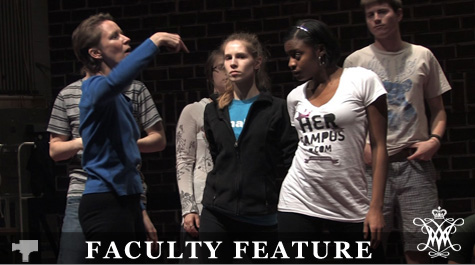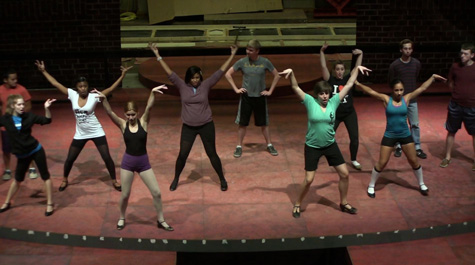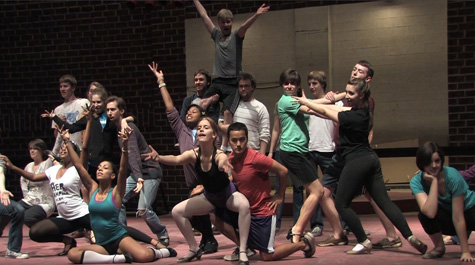Gavaler helps actors embody 'Cabaret' characters
Joan Gavaler begins rehearsal by having the William & Mary students that gather on the stage of Phi Beta Kappa Hall perform a series of stretches, reaching their arms high and then wide and later swinging their hips to different points on an imaginary clock around their midsections.
“Now, let your character enter your body,” Gavaler instructs. “Feel that energy.”
After a few seconds, Gavaler asks a series of questions: “How does your character clap? How does your character reach for the top shelf? How does your character pick up something from the floor?”
The students respond with a variety of movements. Some grab roughly for the imaginary items. Others daintily reach with just a thumb and pointer finger. Others don’t do the actions at all, saying “I have someone do that for me.”
The exercise is part of Gavaler’s movement advising and choreography work for the upcoming William & Mary Theatre production of “Cabaret.” The musical, which takes place in Berlin, Germany in the years leading up to World War II, opens in Phi Beta Kappa Hall on Nov. 11 and runs through Nov. 18.
{{youtube:medium:left|AF8kdcHx9Fs}}
The show is set in the fictional German cabaret The Kit Kat Klub, which means quite a bit of choreography work for Gavaler. But Gavaler’s work doesn’t end with the many dance sequences.
“I’m also thinking with the director and helping her to think about the overall arc of the whole production and working with individual actors on their own movement choices, their own physical character choices – how the character lives in their bodies,” she said.
It’s not the type of choreography that Gavaler, a professor of dance and chair of the Department of Theatre, Speech and Dance, is used to doing. She typically works on modern dance, which is showcased each fall on campus during DancEvent. Gavaler also works with students in the Orchesis dance program and choreographs pieces for her colleagues and fellow dance professionals.
“That’s what I’m used to, where I develop a concept and perhaps find music and work with a smaller cast,” she said. “In this case, I’ve got songs that they’re learning, the environment that they’re in, the characters that are actually performing as opposed to the actors playing themselves … the choreography has to be responsive to all those elements.”
But Gavaler does not merely tell the students how to move their bodies.
“Whenever I can, I really enjoy either setting up an improvisational structure or asking the performers, ‘How do you interpret this idea that I’m putting in front of you, what would you do with this?’” she said.
Gavaler watches how students interpret a moment, keeping some movements or asking them to try a different approach.
“Whenever possible, I really like to have the performer be able to contribute,” she said.
The performers in Cabaret have a wide range of dance and acting experience, and so Gavaler works with each on different aspects of movement.
“For those who’ve danced less, they gain some experience with incorporating movement with song,” she said. “Some of our dancers are learning about music in a different way.”
Despite this type of choreography being different than her usual work with modern dance, Gavaler said she loves working on Cabaret.
“I love this show because it is so character-driven, and it is a quirky, unusual kind of character,” she said. “These are people who are expressing, who are reflecting physically a very stressful, difficult historical time period.”
Although everyone now knows what happened as a result of Hitler’s rise to power, the characters in the show are still somewhat innocent in terms of their understanding of what’s beginning to happen in Germany. Throughout the show, the characters begin to change and that is reflected in their movements, said Gavaler.
For example, the level of rudeness escalates as the show progresses. The show begins with patrons interacting with the performers at the Kit Kat Klub in a friendly, even bubbly manner, said Gavaler. But things get increasingly rude as the show goes on until, finally, there’s a fight scene.
“To think about the show as a whole – to go from, oh this is a lot of fun, and then someone’s beaten up at the end – I mean, how did we get there? That’s a very physical thing to have happen, so how did the whole show point in that direction?” she said.
To tell the story completely, Gavaler has been working closely with the show’s director Liz Wiley, music director Gary Green as well as the costume, set and lighting designers.
“So, it’s very much an integrative experience,” she said.
She hopes all of their hard work results in not only an enjoyable experience for the student performers, but the audience, as well.
“I’d like to think that the people who come and see this show will enjoy it with us. I thoroughly enjoy this cast and watching them rehearse. I have a great time,” she said
Gavaler said she also hopes that the show prompts audience members to think about the time right before the rise of Nazi Germany and “how we see things when we look back as opposed to how they look when we’re experiencing them.”
“What are we experiencing right now that we’ll see very differently in 20 years and 30 years?” she asked.


















